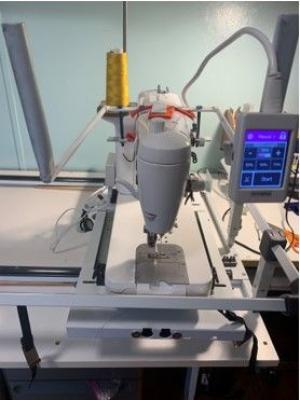2023 - Volume #47, Issue #4, Page #22
[ Sample Stories From This Issue | List of All Stories In This Issue | Print this story
| Read this issue]
Sewing Machine Quilting Frame
 |
“Large quilts became quite cumbersome when trying to fit them through the space between the needle and the body of the sewing machine, known as the throat,” says Perron. “Quilting the layers became easier with the introduction of long-arm quilters manufactured especially for home use.” These specialty sewing machines have larger throats, allowing more material to pass between the needle and the neck.
In contrast, Perron’s machine was not designed with quilting in mind. She explains, “I found myself making many quilt tops on my Juki sewing machine and either tying them off or attempting to tack the layers with sporadic sewing. I decided it was time to ‘graduate’ to a long-arm machine.”
Pricing for a simple frame and carriage starts at around $600, while more intricate frames and long-arm machines with programable software can run $25,000 or more. “While I would love a more expensive set-up, I opted to purchase a Grace Co. frame and use my own sewing machine on the carriage,” she says. “The carriage had handles that came out under the frame about 18 in. at hip height. I decided I wanted shoulder-height handlebars instead. Aftermarket handles would cost about $300.”
Perron’s husband fabricated her handlebars himself from leftover materials from other projects. “Looking at a sewing machine with the needle in front of you (rather than on the right), he made a saddle about 9 in. wide from steel he had in his workshop. He took the metal and curved it to mount on the top of the sewing machine body from left to right. He also bent another 9-in. piece for the bottom of the saddle and used long bolts to hold the top and bottom pieces together. He added felt between the sewing machine and saddle top and bottom to prevent scratches. He then added perpendicular bars about 13 in. long to support the handles, and I use them to drive the machine. Also, on the handles, I mount my stitch regulator when I choose to use it rather than a foot pedal.”
This simple upgrade significantly improves Perron’s stability as she stitches her quilts. “The only thing I would add would be bicycle handlebar grips which are molded to fit between fingers,” she says.
Contact: FARM SHOW Followup, Marian Perron (ph 802-734-7609).

Click here to download page story appeared in.

Click here to read entire issue
To read the rest of this story, download this issue below or click here to register with your account number.




